This post may contain affiliate links. Please read our disclosure policy.
With just a couple of pantry-friendly ingredients, you can make your own delicious homemade oat milk with creamy, rich results every time.
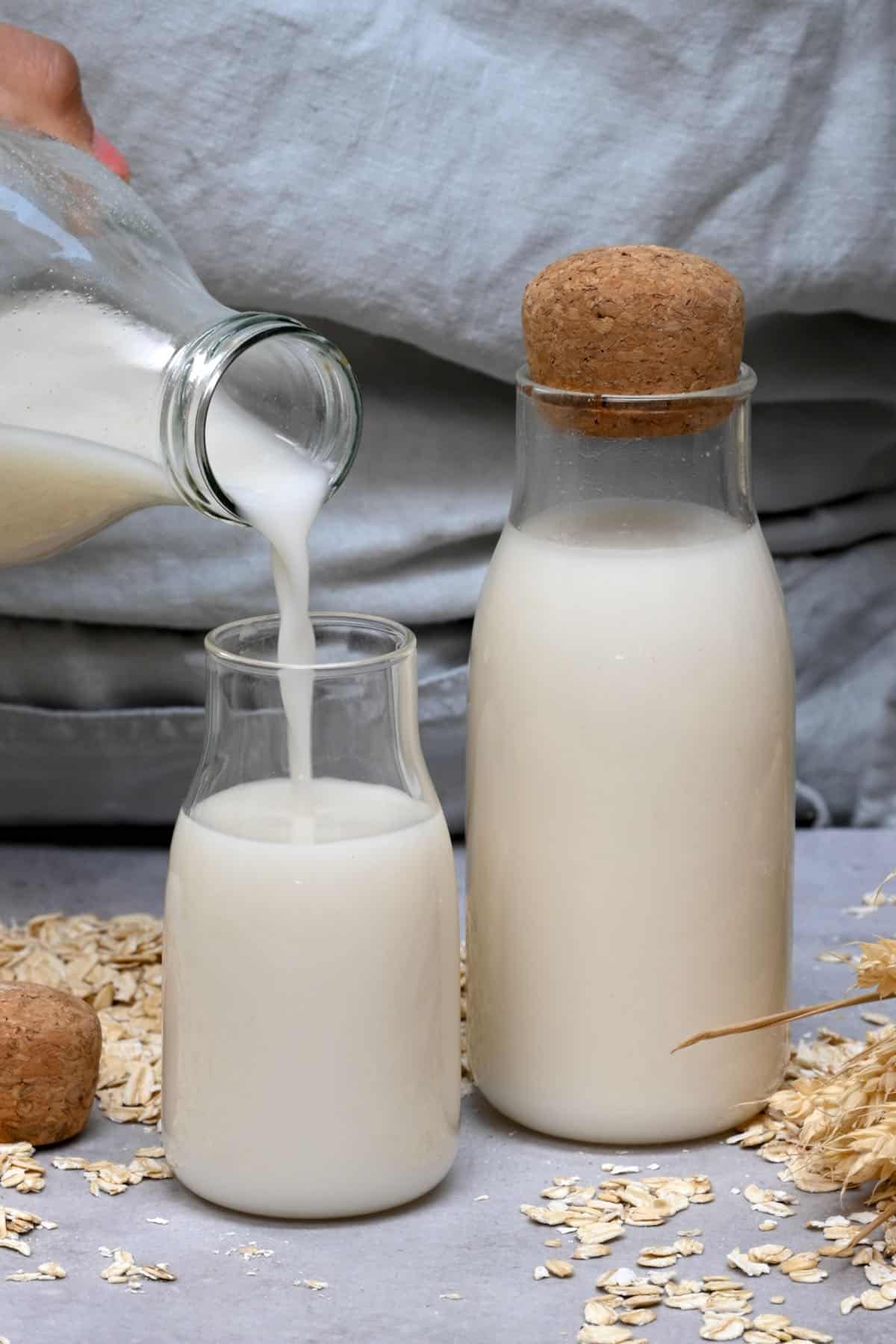
Making oat milk isn’t as daunting as it might sound it’s surprisingly easy! Being one of the most popular dairy-free milk varieties, my DIY oat milk gets a little sweetness from maple syrup and vanilla extract and makes a perfect substitution for dairy milk in baking, for breakfast, or even just in your cup of coffee.
I’ve spent a long time perfecting my oat milk recipe so it doesn’t turn out slimy, has a deliciously creamy taste, and is quick and easy to make.
Want to save this recipe?
Oat Milk Ingredients
- Rolled Oats: I prefer to use organic oats, but you can use any you have to hand, including steel-cut oats and certified gluten-free oats.
- Cold Water: It should be ice cold.
- Salt: Just a pinch of salt will bring out the sweetness in the milk.
- Maple Syrup (Optional): I like to add this as a sweetener, though you can substitute it with honey (either ordinary or vegan) or agave nectar.
- Vanilla Extract (Optional): I also use this for flavor, though you can adjust the amounts based on your taste.
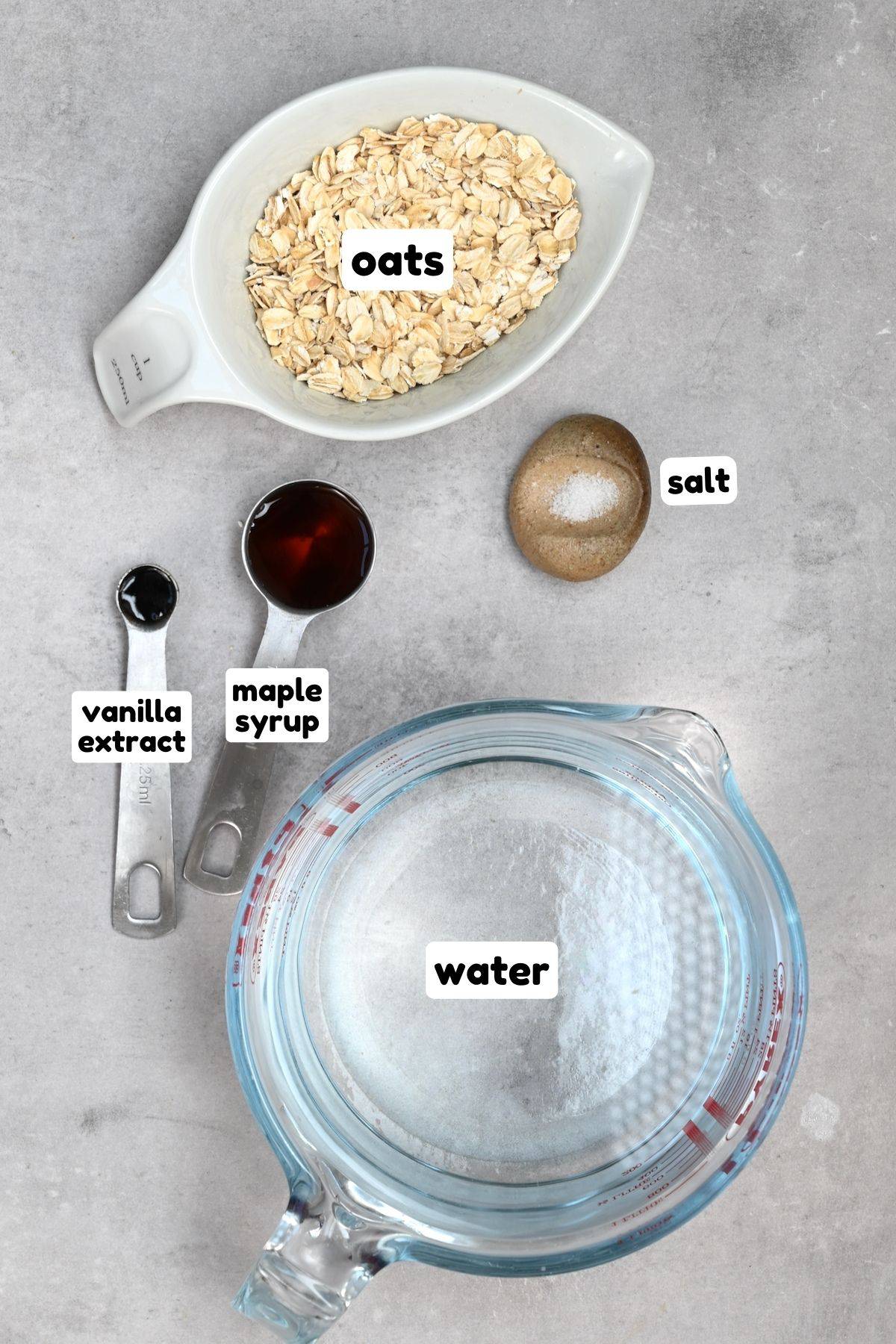
Flavored oat milk
You can flavor your oat milk – just add your desired flavoring either when blending or when ready to drink. These are some of my favorite options:
- Vanilla
- Maple Syrup – or your favorite sweetener. Medjool dates can also work great here if you prefer.
- Cocoa – cocoa powder will make a delicious chocolate oat milk – great for kids!
- Strawberry or your favorite berries.
- Coffee.
How to make oat milk
Add your rolled oats, water, salt, vanilla extract, and maple syrup (if using) to a high-speed blender and blend for 10 seconds (15-20 seconds if you’re not using a high-speed blender).
Once the oats have been fully blended, pour the mixture into a nut milk bag or a fine mesh strainer lined with a few layers of cheesecloth. I recommend having the bag in a bowl already before you pour the oat mix in.
Using your hands, strain the milk through. You should have a thin liquid with no lumps or extra mix in it and the pulp still in the bag. For super-smooth milk, strain the oat milk twice.
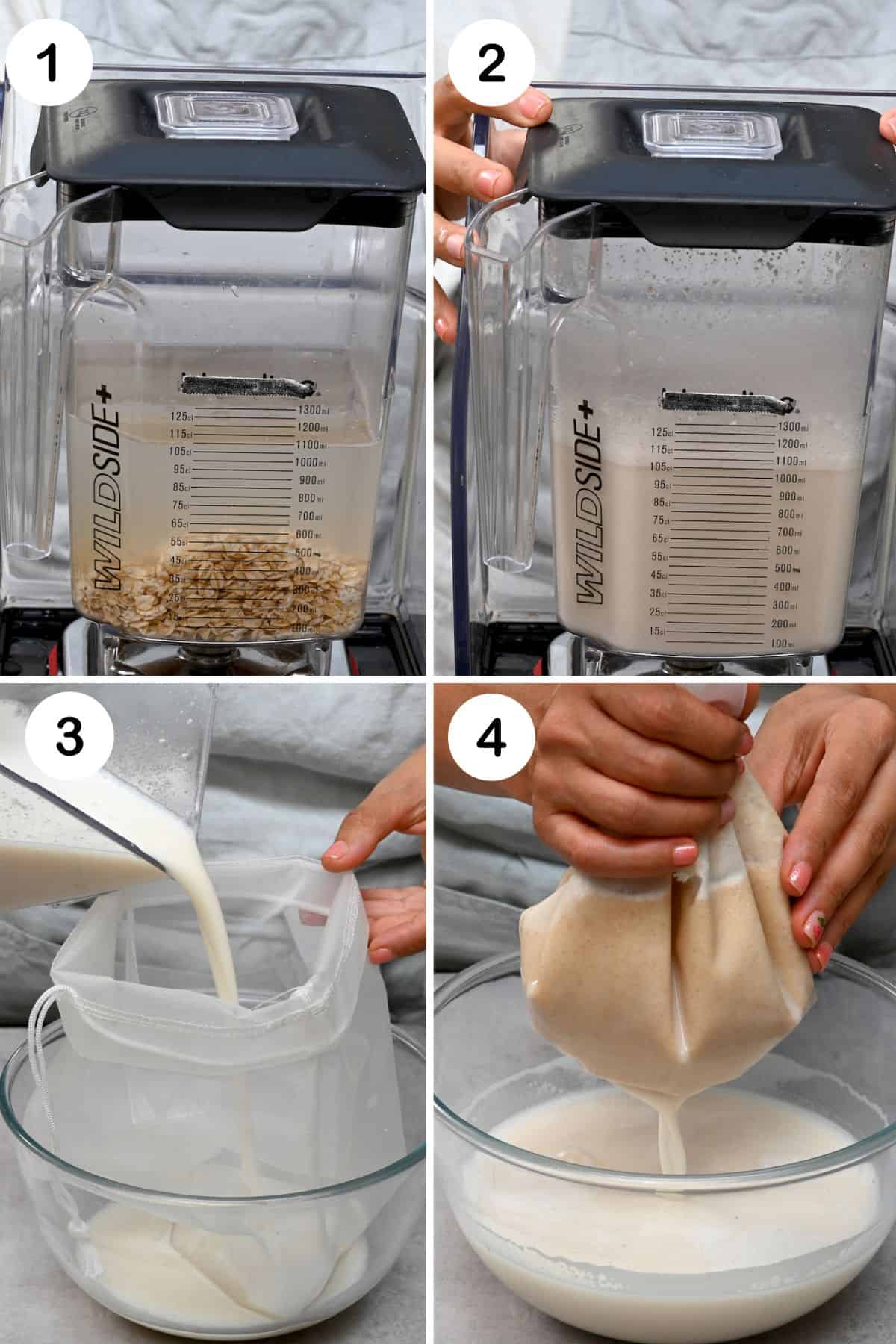
Top tips to avoid slimy oat milk
If you want to make your own oat milk – you don’t want a slimy result! These are my top tips for getting perfect oat milk every time:
- Use Dry Oats: Your oats should be completely dry when you add them to the blender. If they’re wet, they won’t soak up as much of the liquid and will give the milk an unpleasant texture.
- Don’t Over Blend: High-speed blenders work quickly, so you don’t need more than 10 seconds to get the right texture. Over-blending causes heat and friction, which changes the overall composition of the oat milk – making it slimy.
- Don’t Over-Squeeze: The trick when straining is to handle the oat milk as little as possible. Too much squeezing causes more of the starch compounds from the oats to end up in your milk, which results in a slimy thick texture.
- Double-Straining: Straining the oat milk mix twice in the bag will remove any extra pulp and starch that could make the milk slimy.

How to use oat milk
- Use as an alternative to creamer or milk in coffee – try it in a matcha green latte or TikTok favorite, a Dalgona latte. You can also use it to make homemade chocolate milk.
- Substitute in vegan baking and add to my favorite chocolate chip cookies or my healthier chocolate digestives.
- Use for breakfast favorites – this milk is great for chia seed pudding, overnight oats, and smoothie bowls.
What to do with the leftover oat pulp
The leftover pulp can also be used in a variety of ways – and it’s easy to make this recipe completely no waste. Use the pulp for:
- Breakfast dishes, especially overnight oats, muesli, oatmeal, and chia seed pudding.
- Use in baking for extra fiber – it works great for chocolate chip cookies, fudgy brownies, and muffins.
- Add to smoothies for fiber and protein.
- Use around the house – you can use it to make face masks, body masks, and compost.
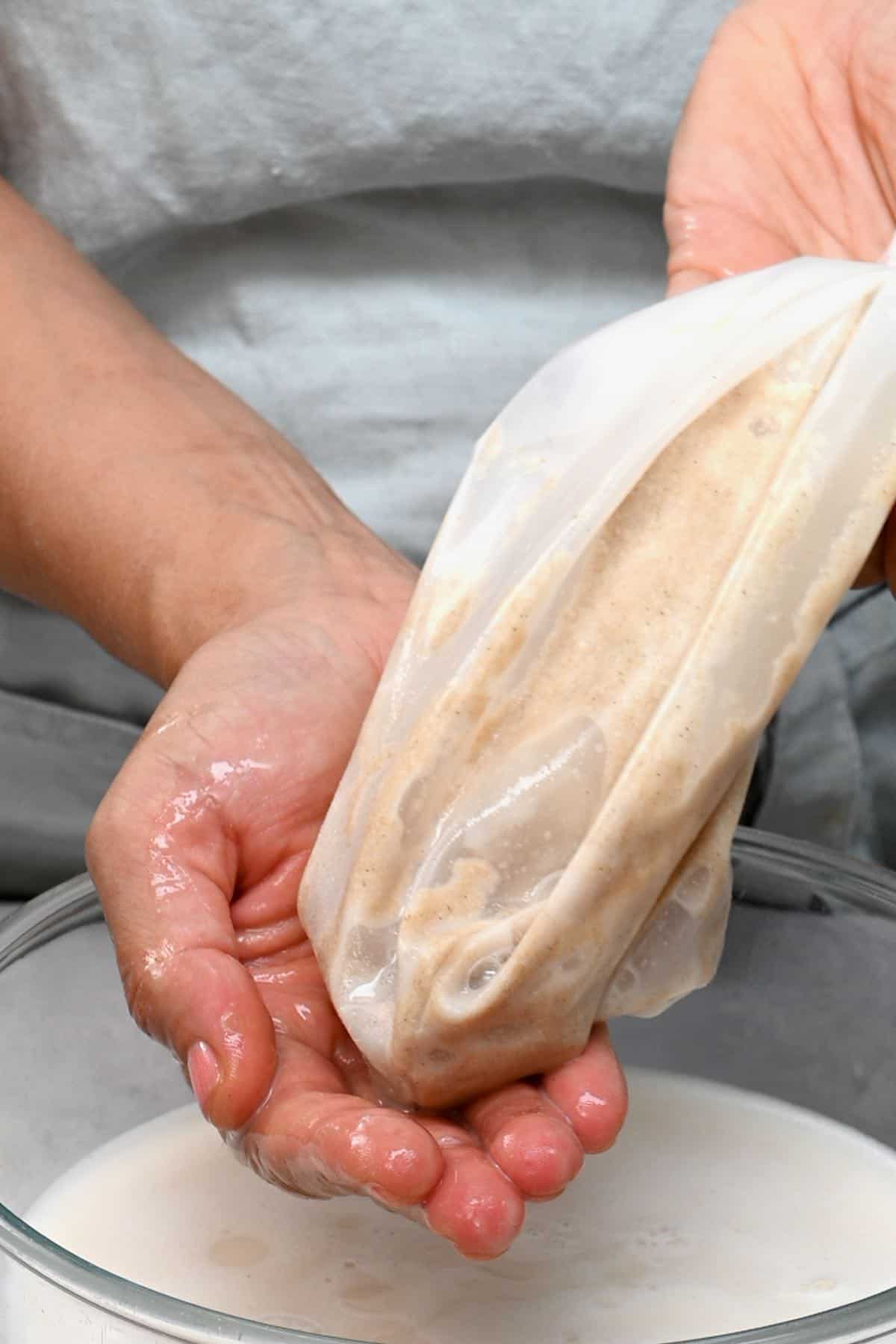
Can you heat oat milk?
Yes – but it’s best to do it slowly. Heat it gently over low to medium heat and stir it until it’s reached your desired temperature. Just be careful to not overheat, as it can thicken and get a strange taste if it’s heated too fast.
How long does homemade oat milk last
Once it is ready, transfer it into pre-sterilized containers or glass jars. Stored in the refrigerator, the homemade milk should be kept for up to 4-5 days. If you decide to use extra flavorings in your oat milk, this can affect the shelf life, so keep an eye on it after a few days.
More homemade plant-based milk recipes
If you try this oat milk recipe, let me know how it goes in the comments below. I’d appreciate a recipe card rating and would love to see your recipe recreations – tag me on Instagram @Alphafoodie!
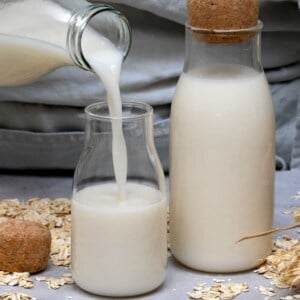
How To Make Oat Milk
Equipment
Ingredients
- 3/4 cup rolled oats use organic and/or gluten-free if needed
- 4 cups water ice cold
- 1/8 tsp salt
- 1 Tbsp maple syrup optional, or sweetener of choice
- 1/4 tsp vanilla extract optional
Instructions
- Add all the ingredients into a high-speed blender and blend for 10 seconds (15-20 seconds if you're not using a high-speed blender).
- Pour the mixture through a nut milk bag or a fine-mesh strainer lined with several layers of cheesecloth (don't over squeeze!).Optional: Strain twice for super-smooth milk.
- Enjoy immediately or transfer to a sterilized bottle.
How To Store
- Fridge: Once bottled, store it in the fridge for 4-5 days, shaking it well between each use. When it's bad, it will start to smell and taste sour/off.Freezer: It will freeze for up to 3 months. However, upon thawing, it may be a little gritty and require re-blending for a few seconds and/or re-straining.
Video
Notes
- Use Dry Oats: Your oats should be completely dry when you add them to the blender. If they’re wet, they won’t soak up as much of the liquid and will give the milk an unpleasant texture.
- Don’t Over Blend: High-speed blenders work quickly, so you don’t need more than 10 seconds to get the right texture. Over-blending causes heat and friction, which changes the overall composition of the oat milk – making it slimy.
- Don’t Over-Squeeze: The trick when straining is to handle the oat milk as little as possible. Too much squeezing causes more of the starch compounds from the oats to end up in your milk, which results in a slimy thick texture.
- Double-Straining: Straining the oat mix twice in the bag will remove any extra pulp and starch that could make the milk slimy.
- Flavor Options: Add your desired flavoring when blending or when ready to drink. Here are some of my favorite options:
- Vanilla
- Maple Syrup or your favorite sweetener. Medjool dates can also work great here if you prefer.
- Cocoa to make chocolate milk.
- Strawberries or other berries.
Nutrition
Nutrition information is automatically calculated, so should only be used as an approximation.

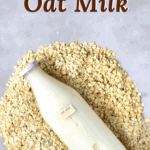
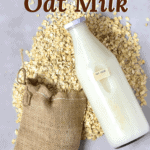


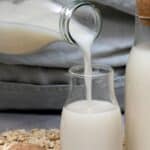










Mine slimed. What can I do with slimy oat milk?
Hi Maureen,
I am sorry to hear it slimed. You could still add it to a smoothie or a soup where it won’t feel slimy.
To avoid sliminess, make sure the milk is not over-processed in the blender. I hope this helps. 🙂
This is honestly the very best oat milk I’ve ever had! I’m so happy you posted this recipe, I’ve made it twice now and I haven’t been disappointed.
Yay! glad to hear you’ve had such great results – I do love homemade oat milk <3
i just tried it and i love it, not slimy at all! i added soaked almonds because i didn’t have cashews. my only question is, the milk is not as white as in your picture. i wonder what could be the cause? not blended enough? i used a regular strainer because i don’t have a nut milk bag? or because of the almonds?
i’ll make it again and see but was just wondering if you’ve encountered that before..
Hi Anne,
Thank you for your comment. I am glad you loved the oat milk. 🙂
Were the almonds blanched? If not (if they had their skin), that would change the color a bit. It could also depend on the exact type of oats you used.
Is there a way to prevent it from sinking to the bottom? I experimented a lot and achieved a really nice taste and texture, yet after a few minutes mixed with coffee it starts sinking so I have to stir it each time I fancy a sip…
Hi El,
Usually, it’s the acidity of coffee that causes this separation (the oat milk sinks to the bottom). As for homemade oat milk we don’t use any of the commercial stabilizers, it might be a bit tricky to resolve this. I wouldn’t want to suggest using less acidic coffee or diluting it with more water (though these tricks might work), but you could try one of these options: 1. heat the milk a bit (just under 140ºF/60ºC); 2. let the coffee cool a bit before adding the milk; 3. slowly add the coffee to the milk. I hope one of these helps.
How would you adapt this if using a NutraMilk blender?
Hi Darlene,
Sorry for the late reply. I am using in here the nutramilk blender too (see step photos)
can I make it in a food processor instead of blender? I don’t have a high teck blender.
Hi, of course you can! just the one thing to remember is not to over process!
What kind of oats ? Quick oats? Rolled oats? Steel ?
Rolled oats are what I use 🙂
How long does this last without perishing in a fridge?
usually 4-5 days in the fridge
Can you use steel cut oats for this recipe?
Hi Lika,
Yes, you can use steel-cut oats. The texture may differ slightly but it should still work.
Tried your recipe this morning because I was desperate for a creamy cup of coffee without the crazy ingredients list that non-dairy creamers have. I added the cashews for extra creaminess and I was thrilled with the outcome. No slime like I was experiencing with prior oat milk trials.
Perfect! It took me quite a few tries to eliminate the slime but now it is definitely one of my absolute favourite dairy-free milk options to make 🙂
Hi can I use almonds instead of cashews.
yes, of course! I love to use cashews just because of how creamy they are but you can combine oats with most nuts I would think. Let me know how it goes if you try it 🙂
I read all recipe and try it today and loooovve it
Yay – I’m glad to hear that! It’s one of my favourite dairy-free milk option to be honest.